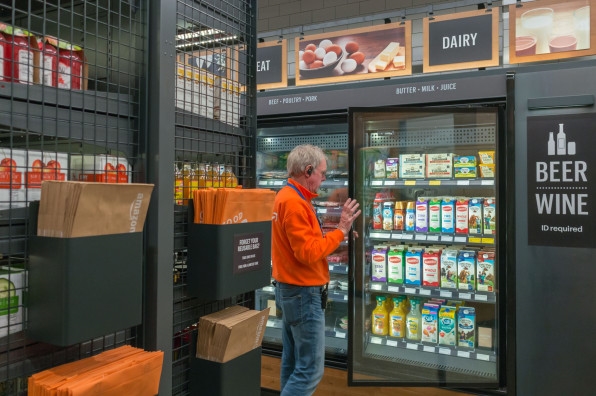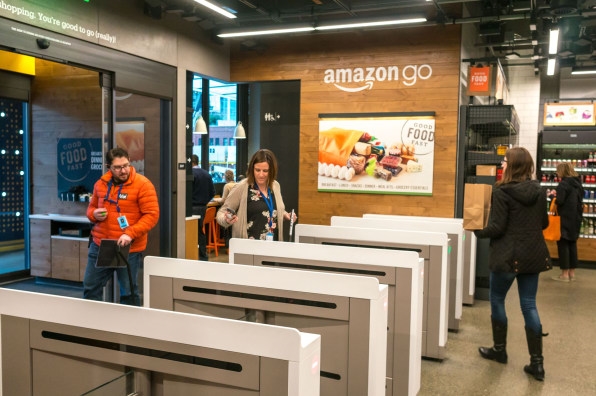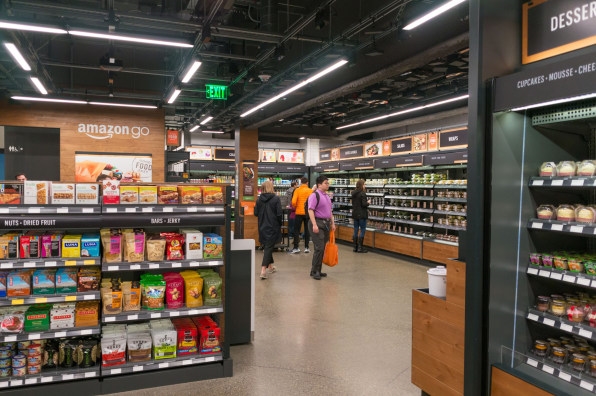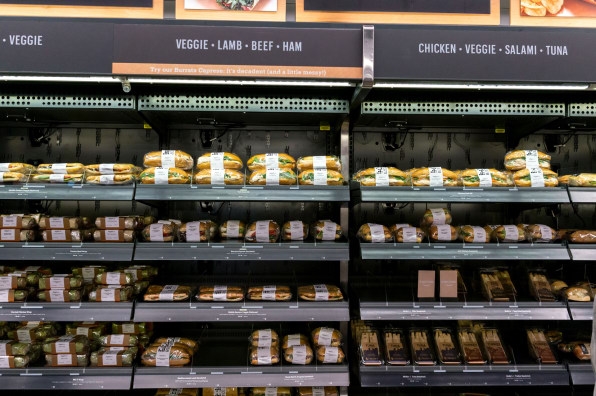Every part of the U.S. has a different local term for a convenience store: the bodega, the corner store—even “the Wawa,” a chain name that Northeasteners use generically. Now Amazon wants to extend its brand to the notion of a grab-and-go shop with Amazon Go, a store that literally lets you grab and go. On Monday, more than a year after the company unveiled the concept and began a beta-test phase open only to its own employees, the first Amazon Go in Seattle will welcome all shoppers.
In December 2016, when the company first teased the automated store–which eliminates cashiers and checkouts in favor of AI and cameras that detect the products you select—it said that it was coming in early 2017. Last March, however, the Wall Street Journal’s Laura Stevens reported that Amazon was having trouble getting its “Just Walk Out” technology to work as the place filled up with customers. Amazon Go’s VP of technology, Dilip Kumar, who gave me a pre-opening tour, acknowledges that Amazon had expected to let in non-Amazonians earlier. But he says that the delay was because its employees embraced the beta program, providing enough willing participants until the store was ready to exit its beta phase.
For now, Amazon Go has a single location deep in Amazon’s own world. It’s on the ground level of Amazon’s Day 1 skyscraper, next to its Spheres, which are sort of giant-scale terrariums. (Kumar says that the company expects to roll out more locations on an unspecified timeline.) The store has been highly visible from the sidewalk since it opened to employees, with windows into the kitchens that let passersby watch staff make fresh prepared food and meal kits.

Amazon Go works like—well, like a physical manifestation of Amazon’s 1-Click checkout, where you “click” by taking an item off a shelf. On arrival, you launch the Go app, which comes out today for iPhones and Android phones and connects to your Amazon account. It displays a 2D code that you scan at one of several glass security gates. The code identifies you to the store and opens the gate. (You can also check in other people—a spouse, a kid, a friend—whose purchases will be added to your tab.) Once you’re in, AI algorithms start to track you and everything you pick up and keep. You can bag your items as you go if you so choose, and need interact with an employee only if you’re buying alcohol, in which case an associate standing in the liquor area will check your ID.
Using a phone provided by Amazon, I tested the system by picking up a can of LaCroix water and leaving the store. It was a non-event, which is sort of the point. The experience doesn’t feel like an act of advanced technology unless you scan the ceiling and notice the hundreds of matte-black cameras surveying the shopping floor below. “You can just walk in, take what you want, and leave,” says Kumar.

The Software Behind The Store
Just how the store keeps track of you and your purchases isn’t clear. Kumar deflected questions about AI back to the customer experience, and the company has provided little detail about how the Go technology works behind the scenes other than saying it’s developed software to perform tasks such as identifying products—whether they’re on a shelf or off it, and even if they’re partially obscured by something else. (The store doesn’t use more conventional technologies such as RFID tags to track items, but can take a cue from a normal barcode on a product.)
“You use machine learning and use computer vision in a way that makes this experience completely seamless,” says Kumar. “We have spent a lot of time figuring out how to make our algorithms and our sensors reliable, highly available, and very efficient so that you get things right and we’re very accurate.”
Despite the Wall Street Journal’s report of early glitches, Amazon’s back-end system is ostensibly now powerful enough to handle a store full of shoppers, up to maximum capacity as established by the fire code. Kumar says that Go won’t impose any limit lower than that. During my tour, a constant stream of Amazonians passed through the store. They weren’t plants, and I didn’t see any frustrated purchasers.
The necessary processing capacity and software to track dozens of people and their purchases would have sounded implausible a few years ago. But compared to driverless cars—already an impending reality, involving chaotic uncontrolled situations with unpredictable numbers of people, vehicles, and other stuff—monitoring known items in a fixed location seems a lot more straightforward.
The fact that you can stroll out of Amazon Go at will with products in hand might sound like an invitation to shoplifters. But “overall, we’re not overly concerned about it or overly focused on it,” says Kumar. The store could wind up with a low theft rate just because of the check-in process, which gives it a record of who’s been on the premises.
If you regard the idea of a store watching you shop as a privacy invasion, you might also want to steer clear of today’s garden-variety grocery stores, which are themselves decked out with cameras for security purposes. Facial-recognition technology is already deployed in retail outlets of all sorts and its use will radically increase in coming years. But will Amazon use data from your Go trips to do things like suggesting Prime items to order for home delivery based on what you bought (or didn’t buy) in the store? We don’t yet know, because the company isn’t saying much about how Go fits into its broader relationship with consumers.

The War On (Time) Poverty
Amazon also isn’t providing a direct explanation of why it decided to build an AI-infused convenience store. But it does articulate the customer it has in mind: one with “time poverty.” That category generally includes working professionals who are urban dwellers. They’re busy enough that a regular shopping trip seems unachievable, but they want relatively affordable fresh food instead of processed or frozen goods. That same customer is a target of Amazon’s Whole Foods Markets, which helps clarify the company’s overarching grocery strategy and might provide a clue as to where it could locate future stores.
The Go format also fits with AmazonFresh Pickup, which Amazon has been testing in Seattle. That service offers places to collect grocery orders at your convenience, with no cost for Prime members, instead of having to be home during delivery windows and pay a monthly or yearly subscription fee.
And although Kumar didn’t emphasize it, Amazon Go adds a retail angle to the meal kits Amazon started delivering in mid-2017 via AmazonFresh. Though market leader Blue Apron and others are still struggling to make meal kits profitable, it’s a $5 billion business that analysts expect to double by 2020–and is exactly the kind of inefficient and uncertain market that Amazon likes to wade into with its ability to deploy on a vast scale through multiple channels. This first Amazon Go store makes both meal kits and prepared foods in its adjacent kitchen, but they’d presumably be prepared in a central kitchen in each city or neighborhood if Go rolls out in any quantity.

With a meal kit for two costing less than $20, an Amazon Go store can’t push enough kits on its own to make up a major portion of its revenue, even though they’re high-margin items and the store has no delivery costs. The stores’ bread and butter will be bread and butter—and salads, drinks of both the alcoholic and non-alcoholic variety, chips, and a lot of miscellaneous items. This first store is stocked with Amazon-branded goods, those of major brands, some Whole Foods products, and a few exclusives, including a co-branded chocolate with local high-end chocolatier firm Theo. Unlike a 7-Eleven, Go doesn’t sell convenience-store staples such as cigarettes, lottery tickets, or gift cards, and Amazon has no plans to add them.

It might seem like Amazon Go is designed for introverts, but the real purpose seems to be to serve increasingly dense areas in cities that have gained thousands or tens of thousands of residents and in which the rents are too high to support a typical corner store or grocery. In many places, these shops have already been replaced with high-end restaurants and retail stores, making it tough to pick up groceries without making a trip outside the immediate neighborhood.
In 2017, I worked out of a space two blocks from Amazon Go. Had it been open to the public at the time, I would have welcomed it the few days a week I was in the area, where skyrocketing rents have crowded out groceries of all sizes—except a nearby Whole Foods, where the checkout lines are often long even if you just want a few items. Still, were Go stores to wind up in neighborhoods with other choices, I’d likely prefer the human touch of a mom-and-pop shop.
Truthfully, as Amazon’s second all-new foray into retail after its 13-store brick-and-mortar chain of bookshops, there’s much that Amazon Go doesn’t reinvent, despite the AI gloss. The 1,800-square-foot high-touch, well-lit store, with hip, moderately loud music piped in, feels like a shrunken full-scale supermarket—like a Whole Foods, in fact, even though Amazon says that planning began five years ago, long before the Whole Foods courtship and merger.
In a way that’s classic Amazon, Amazon Go is actually a machine designed for throughput, but the mechanisms that make customers the cogs are hidden. The concept could allow the volume and margins to turn a profit that would be worth making. And it’s a new way for Amazon to gather intensely valuable information about some of its core customers, embedding them even deeper into into the all-encompassing Amazon ecosystem that’s starting to fill every niche. Did I mention reports that the company is apparently looking into filling prescriptions?
Whatever the future holds, Kumar says it’s time for this first store to open: “We feel confident and comfortable, and we’re ready to go.”
Fast Company , Read Full Story
(87)